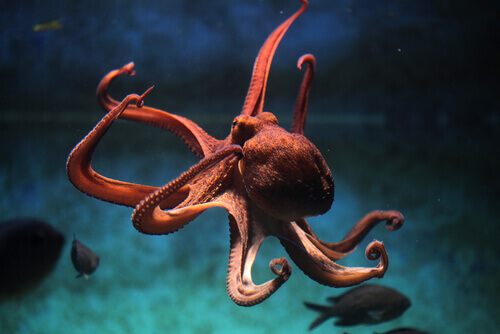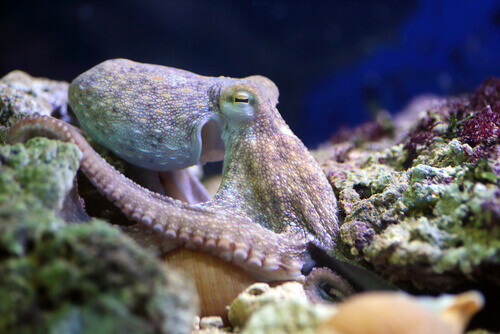Some Curiosities About the Octopus

Octopuses come from the cephalopod family, which are invertebrate mollusks with bulky heads, tentacles and the ability to mimic their surroundings. It’s worth pointing out some impressive curiosities about the octopus.
There are more than 300 known octopus species in marine life. They differ from each other in appearance, size, and habits. Some species are capable of living at depths of more than 4,000 meters (13,100 ft). Others are well adapted to the open sea, even when it comes to defending themselves against predators.
Cephalopods are characterized by their defensive techniques when attacking or holding their prey. First of all, they’re able to mimic their environment by means of advanced camouflage techniques. In the case of octopuses, they can even mimic other animals such as sea snakes.
Along with this squid-like mimicry ability, they employ another important defense and attack mechanism. Octopuses possess a thick sac containing ink, which they usually release when they feel in danger.

What does the octopus look like and where does it live?
The octopus is an invertebrate with eight tentacles, which house up to 40 million chemical receptors. It’s these receptors that give it the sense of taste and smell. Its mouth is a parrot-like beak, which is also employed in transferring material during the manufacturing of its shelter.
With no bones, octopuses use their muscles to stiffen their bodies, by contracting and relaxing them. A peculiarity that attracts a lot of attention is their ability to squeeze into any given space. Their body is malleable and, therefore, they can hide in very narrow crevices.
Octopuses mainly inhabit salty warm waters. However, larger specimens have been seen in cold waters. They’re carnivorous by nature and feed on fish, crustaceans, and even algae. In many cases, they use their tentacles as a lure to attract prey. They also use them skillfully in order to open clams or shells.

Eight curiosities about octopus
- They have three hearts. Two of the hearts pump blood to the gills, while the third pumps blood to the rest of the body.
- Their blood is blue. Instead of hemoglobin, octopuses use hemocyanin to oxygenate their blood. The high copper content of this protein gives their blood a bluish color.
- They’re poisonous. To a greater or lesser extent, octopuses have toxins that can be irritating to the skin and mucous membranes. The venom they use can paralyze their prey to then get a hold of it. However, only in the case of the blue-ringed octopus does this toxin have an effect on humans.
- They have high-level cognition. Octopuses are famous for their intelligence. In certain cases, they’ve been compared to dolphins, which are recognized for their learning ability.
They’ve been shown to be able to learn from positive and negative stimuli. In addition, they have the ability to remember sensations, and this enables them to avoid the same situation.
Survival and awareness
- They apply survival techniques. As part of their defense strategies, octopuses are experts at imitating more than 15 species of marine animals. Many of these are highly venomous, so potential predators are deterred from attacking.
Another of the curiosities about the octopus is that it’s capable of amputating its own tentacle as a method of escape. Its tentacles have the ability to regenerate. Moreover, they can recognize their lost limb, and differentiate it from that of other species.
- They’re self-aware. The octopus is part of the “Cambridge Declaration on Consciousness”, a manifesto that lists animals with self-awareness. This ability is thanks to the secretion of serotonin, a hormone related to mood.
- They’re incapable of entanglement. Octopuses have a substance on their tentacles that prevents their limbs from becoming entangled. They employ their tentacles for walking, swimming and grasping. In order to move, they employ stereotypical patterns that allow them to control their body.
- Octopuses are color blind. They can’t differentiate between shades of red, and sometimes neither between green and blue.
This text is provided for informational purposes only and does not replace consultation with a professional. If in doubt, consult your specialist.